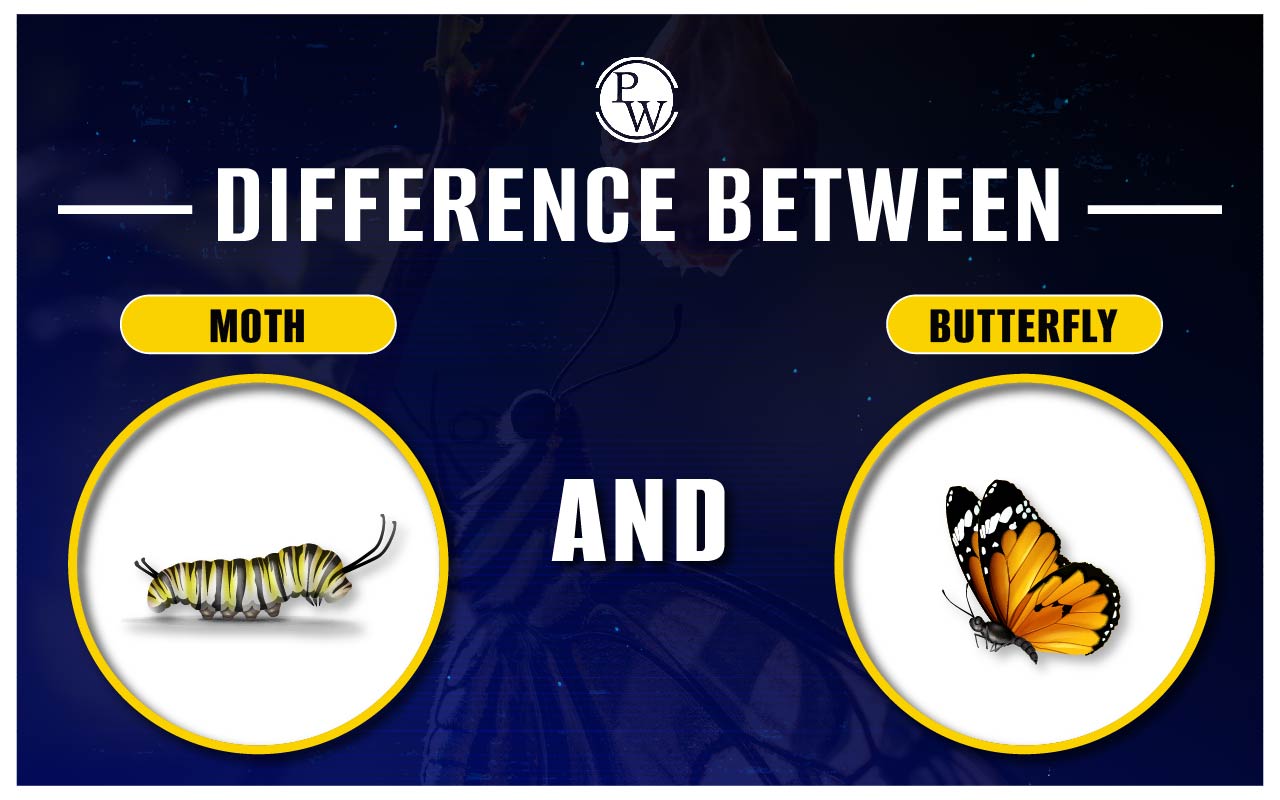

Difference Between Moth and Butterfly: Butterfly and moth species are insects that belong to the same family. They have many similarities as well as differences. The main difference is their activity patterns. Moths are nocturnal. It means they are active at night, whereas butterflies are diurnal. It means they are active during the day.
Furthermore, moths have bigger bodies with feathery or filament-like antennae, whereas butterflies have smaller bodies with club-shaped antennae. Read the article below for the complete details about the difference between moth and butterfly.
Difference Between Moth and Butterfly Overview
Moths and butterflies are members of the Lepidoptera order of insects. Many modifications of the fundamental body form have developed to achieve advantages in lifestyle and dispersal in the Lepidoptera. The hierarchy that covers the body, wings, and proboscis differentiates Lepidoptera.
Similarly, moths and butterflies differ significantly in terms of color and design. Both butterflies and moths play important roles in ecosystem management by acting as pollinators and maintaining the food web or food chain process. However, their larval phase can cause issues for farmers because their primary food source is plant
| NEET Biology Syllabus | NEET Biology Diagrams |
| NEET Biology MCQ | NEET Biology Chapter wise Weightage |
| NEET Biology Notes | NEET Previous Year Question papers |
Difference Between Moth and Butterfly
The ecosystem has around 1,80,000 Lepidoptera species. Butterflies are members of the Papilionoidea superfamily of the order Lepidoptera. Butterflies are active throughout the day and are generally vividly colored or patterned.
Moths are a paraphyletic group of insects in the order Lepidoptera. There are around 160,000 species of moths. The majority of which are unknown. They are primarily active at night. The complete difference between Moth and Butterfly is given below in the table.
| Difference Between Moth and Butterfly | ||
| Basis | Moth | Butterfly |
| Wings | Moths land with wings spread and rest with wings open. It helps in nocturnal activities. | Butterflies land with wings folded back, contributing to a streamlined appearance. Wings are closed at rest. |
| Size and Color | Generally smaller with drab-colored wings, they promote camouflage during nighttime activities. | Typically larger with more vibrant patterns, they serve functions like mate attraction and species recognition during daylight hours. |
| Antenna | Short, feathery antennae, often with a sawed edge, are specialized for pheromone detection. | Thin, long, almost club-shaped antennae with a bulb at the end is essential for sensory perception and environmental cues. |
| Activity | Primarily nocturnal, being more active at night to avoid daytime predators. | Primarily diurnal, active during the day, and take advantage of sunlight for flight and flower visits. |
| Pupa Stage | It creates a silky cocoon. Some may design a pupation chamber in the ground. | It forms a shiny, hard, silkless, and smooth chrysalis that protects it during the pupal stage. |
| Frenulum | Moths may or may not have a frenulum depending on the species. | Generally, no butterfly, except the Australian Regent Skipper, has a frenulum that makes it a unique feature of certain moth species. |
| Caterpillars | Fuzzy appearance in the caterpillar stage, possibly for insulation and camouflage. | Smoother coat in the caterpillar stage, reflecting adaptations related to specific environmental factors and survival strategies. |
| Body Shape | Shorter bodies with thicker hair, presenting a robust appearance. | Skinnier, longer bodies and more elongated overall body shape, possibly linked to flight patterns and ecological roles. |
Moth
Moths are insects that are classified as lepidoptera. They come in a variety of forms, sizes, and colors, but the majority of them are active at night. Moths fly using their wings, which are coated with microscopic scales. Moths are differentiated by their thread or feathery-like antennae, which aid in detecting pheromones generated by possible mates.
Moths go through a life cycle known as metamorphosis, which begins with eggs produced by adult moths. These eggs develop into caterpillars, which pupate before emerging as adult moths. Moths are important pollinators for certain plants and food sources for many animals in ecosystems. Some moths are also noted for their ability to blend with their environment, which helps them avoid predators. Moths are intriguing insects with many traits and necessary ecological tasks.
Butterfly
Butterflies are pretty insects that are members of the same family as moths. Butterflies go through four phases of development: egg, pupa (chrysalis), caterpillar (larva), and adult. The development begins when a female butterfly drops small eggs on host plants.
Caterpillars emerge from these eggs and are voracious feeders by eating leaves and expanding quickly. After a feeding phase, the caterpillar transforms into a chrysalis, when it experiences a remarkable transformation known as metamorphosis.
The caterpillary changes dramatically inside the chrysalis before emerging as a fully-fledged butterfly. Adult butterflies have scaled, delicate wings in various vivid colors and patterns. They suck nectar from flowers via their proboscis, a long, coiled tube.
Butterflies are important pollinators because they help plants reproduce by transporting pollen from one blossom to another. They are also recognized for their contributions to gardens and ecosystems.
Physics Wallah offers the best NEET online coaching in India at a very affordable price, providing high-quality coaching at an affordable price. With its comprehensive study material, user-friendly platform, experienced faculty, and effective assessment methods, PW is committed to helping students excel in their NEET preparations and succeed in the highly competitive medical entrance exam.
The NEET online coaching platform offers a user-friendly interface that allows students to easily navigate the study material, attend live classes, and access recorded lectures.
Difference Between Moth and Butterfly FAQs
What is the difference between a moth and a butterfly?
Is a moth considered a butterfly?
Which is a kind of moth that looks like a butterfly?
Can moths bite?
Is a purple butterfly present?












